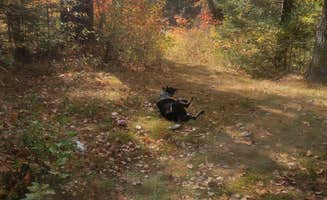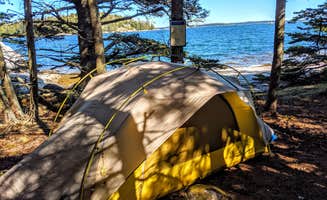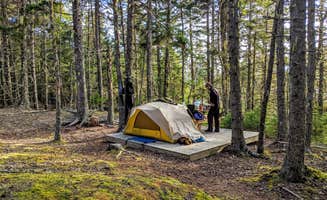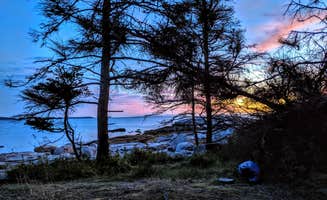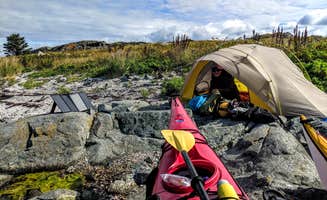Dispersed camping near Otis, Maine focuses on areas beyond the immediate town, with opportunities in downeast Maine's unique terrain. The region features granite-rich coastal landscapes and inland forest areas where campers can enjoy free or low-cost primitive camping experiences. Summer temperatures typically range from 60-80°F with frequent coastal fog and cooler nights that make campfires particularly welcome at mainland sites.
What to do
Shoreline exploration: At Wheat Island, visitors can use the campsite as a base for exploring nearby Isle au Haut, a remote section of Acadia National Park. "Perfect island for exploring the close-by Isle au Haut, a remote section of Acadia National Park, but very hard to get reservations at Duck Harbor Campground," notes one camper who appreciates this alternative access point.
Fishing opportunities: The waterways near dispersed camping areas provide excellent fishing. One visitor at Machias Rips Campsite reports, "Great spot to fish and swim! I've caught smallmouth bass, chubs and trout in the river so far! Black and silver Jerk baits work great." The riverside location makes it easy to access fishing spots directly from camp.
Nature trail hiking: Some dispersed sites offer unmarked trails for day exploration. "There is also a marked trail in the camp that leads deep into the woods, I followed it for about a mile before it got too thick for my interest. Could be the trail that connects to the large pools of water up the river with additional camping there as well," explains a visitor describing the hiking options beyond the immediate camping area.
What campers like
Solitude with easy access: Free dispersed camping areas provide a balance of remoteness and accessibility. "Beautiful place. Clean sites. Easy to find and right off rt 9," mentions a reviewer about their experience. This accessibility makes it popular for travelers who want to avoid developed campgrounds but still need reliable access.
Beach stargazing: Marshall Island offers exceptional night sky viewing from its beaches. "Sand Cove is perfect for a beach fire and stargazing on a clear night—some of the best stargazing spots we've ever seen!" A visitor notes that despite nearby islands having mosquito problems, this location was remarkably bug-free.
Shell collecting: The coastal island sites provide unique beach combing opportunities. "Gorgeous shell covered beach and a beautiful view of Isle au Haut, just next door," writes a visitor about Doliver Island, highlighting the natural treasures that can be found along the shore during low tide.
What you should know
Access logistics: Finding some dispersed sites requires careful navigation. "The dirt road leading to the camp can be easily missed if not paying attention! But is clearly marked with a blue sign at the head of the road. Your GPS might not give you an 'exact' location but I promise I found the place with no problem!" shares a visitor who successfully located a riverside site despite minimal signage.
Tidal considerations: For coastal camping, timing arrival with tides is essential. "This can be a tricky island to land on at high tide, so plan accordingly," warns a kayaker about coastal access. Island landings require planning around tidal cycles, with some sites becoming difficult or impossible to access during certain tide stages.
Variable cell coverage: Connectivity varies significantly between sites. "Most Cell phone carriers won't have service back at the camp, I myself had to drive 20 Minutes up the road for signal, A cell signal booster may work here. Radio signal is fine tho," reports one camper. Interestingly, another visitor to the same location noted, "we had 4 bars of LTE service (AT&T) which was nice," showing the variability between carriers.
Tips for camping with families
Beginner-friendly islands: Some islands are more suitable for first-time kayak campers with children. Buckle Island provides an accessible introduction to sea kayak camping: "This is a perfect island for those new to sea kayak camping as the sandy shore, which is exposed for a good portion of the day, is easy to land on and a short walk to a trail into the woods."
Space considerations: Some sites accommodate larger groups better than others. "This island has 2 sites—one very small one on the northeast side, the other perfect for larger groups on the southwest side," explains a visitor about site selection when traveling with multiple people or families.
Bug preparation: Insect protection is essential for comfortable family camping. "Be prepared for mosquitoes. We thought we were passed mosquito season in early September, but alas, they were pretty bad all day long," reports a camper who was caught unprepared. Families should pack appropriate repellents, netting, or protective clothing depending on the season.
Tips from RVers
Size limitations: RV campers should understand site constraints at dispersed locations. "There is about 4 Sites with river front views and trails leading to the water from each camp. There are also bigger sites for campers and RVs," notes a visitor at Machias River Camp off Route 9, indicating that while some RV camping is possible, sites are limited and primitive.
Road conditions: Access roads to dispersed sites may present challenges. "The road has a few pot holes but nothing my stock (Low to the ground) Dodge Caravan couldn't handle," shares a camper, suggesting that while passenger vehicles can navigate the roads, larger RVs should approach with caution and consider ground clearance.
Facility awareness: RVers must prepare for minimal amenities. "New style out houses are on site but other than that it's completely off grid!" explains one visitor about the limited facilities. RVers accustomed to hookups need to arrive fully self-contained with adequate water, waste capacity, and power solutions.


